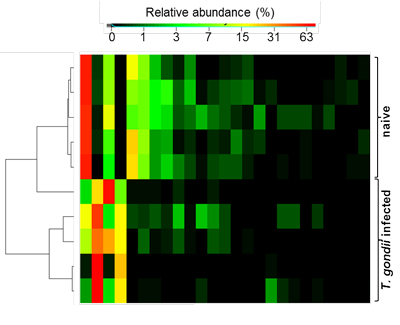Mucosal Immunity to Toxoplasma gondii
 Toxoplasma gondii is a common food borne pathogen. It is estimated that 1.5 million people in the U.S. alone become infected with T. gondii annually. This protozoan parasite is the second most prevalent deadly food borne pathogen in United. While much attention was focused on infections during pregnancy that result in stillbirth, early prenatal death, or serious health problems for the baby after birth, such as eye or brain damage, intestinal symptoms are poorly studied and are frequently confused with those triggered by other food borne pathogens. Our studies comparing T. gondii infected gnotobiotic (germ-free) animals to conventional mice have established that the immunostimulatory signals induced by intestinal bacteria have major effects on the outcomes of the parasitic infections. We have revealed that lack of intestinal bacteria not only results in multiple defects in T cell activation but also results in a dramatic increase in susceptibility to the parasitic infection. Importantly, coexistence of the host mucosal immune system and the intestinal microbiota ensures a balanced immune response that, while fully sufficient for the initiation of protective immunity against accidental intestinal invaders, results in minimal mucosal immunopathology.
Toxoplasma gondii is a common food borne pathogen. It is estimated that 1.5 million people in the U.S. alone become infected with T. gondii annually. This protozoan parasite is the second most prevalent deadly food borne pathogen in United. While much attention was focused on infections during pregnancy that result in stillbirth, early prenatal death, or serious health problems for the baby after birth, such as eye or brain damage, intestinal symptoms are poorly studied and are frequently confused with those triggered by other food borne pathogens. Our studies comparing T. gondii infected gnotobiotic (germ-free) animals to conventional mice have established that the immunostimulatory signals induced by intestinal bacteria have major effects on the outcomes of the parasitic infections. We have revealed that lack of intestinal bacteria not only results in multiple defects in T cell activation but also results in a dramatic increase in susceptibility to the parasitic infection. Importantly, coexistence of the host mucosal immune system and the intestinal microbiota ensures a balanced immune response that, while fully sufficient for the initiation of protective immunity against accidental intestinal invaders, results in minimal mucosal immunopathology.
We have developed new experimental tools and approaches that will allow us to: (i) identify and visualize intestinal bacterial species during T. gondii infection, (ii) identify innate immune receptors involved in sensing T. gondii infection-associated microbiota, (iii) identify and examine the major IFN-gamma-producing cells during T. gondii infection.
Our goal is to gain a precise understanding of the molecular mechanisms of T. gondii-induced intestinal immunopathology.